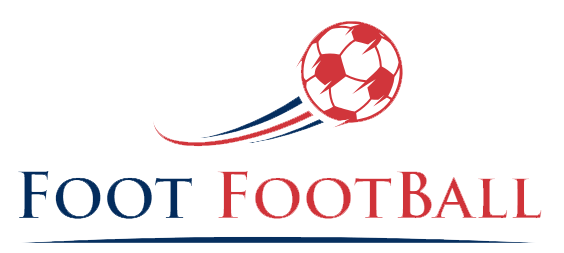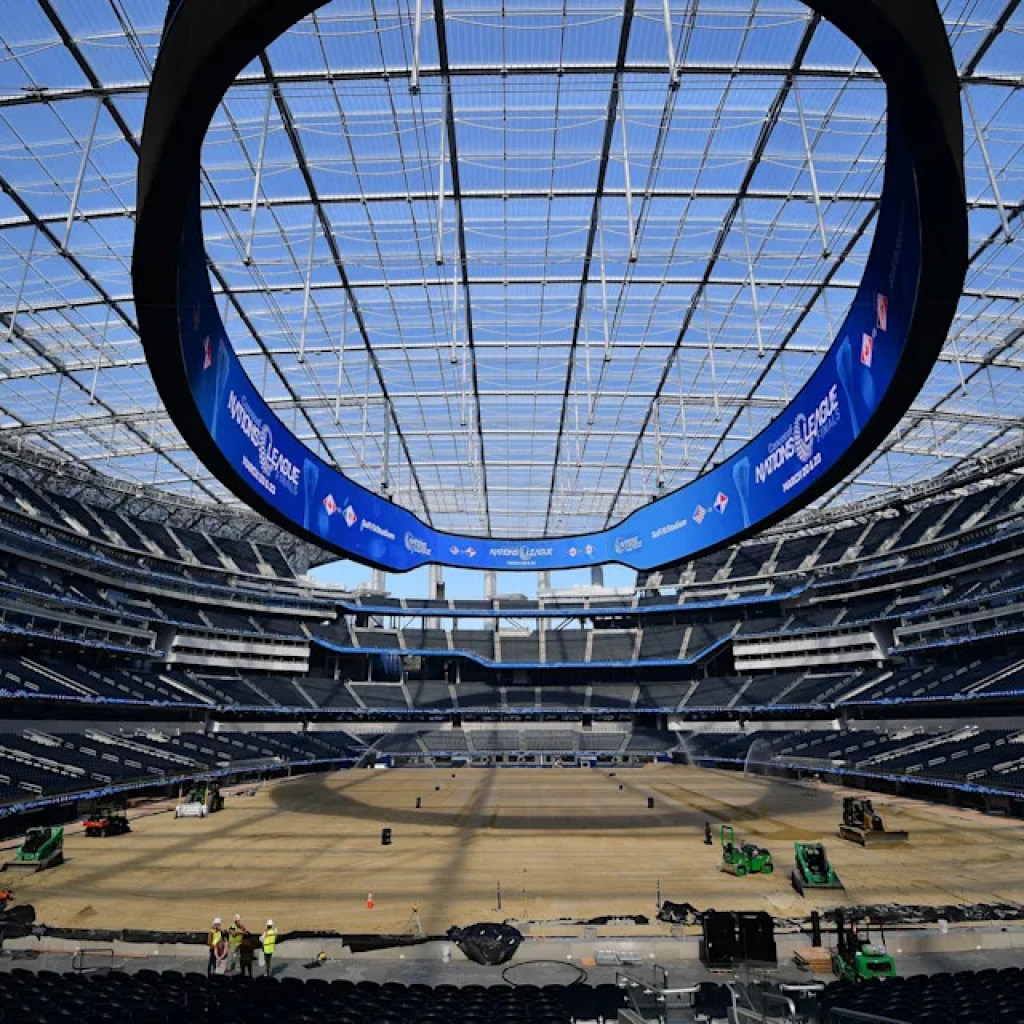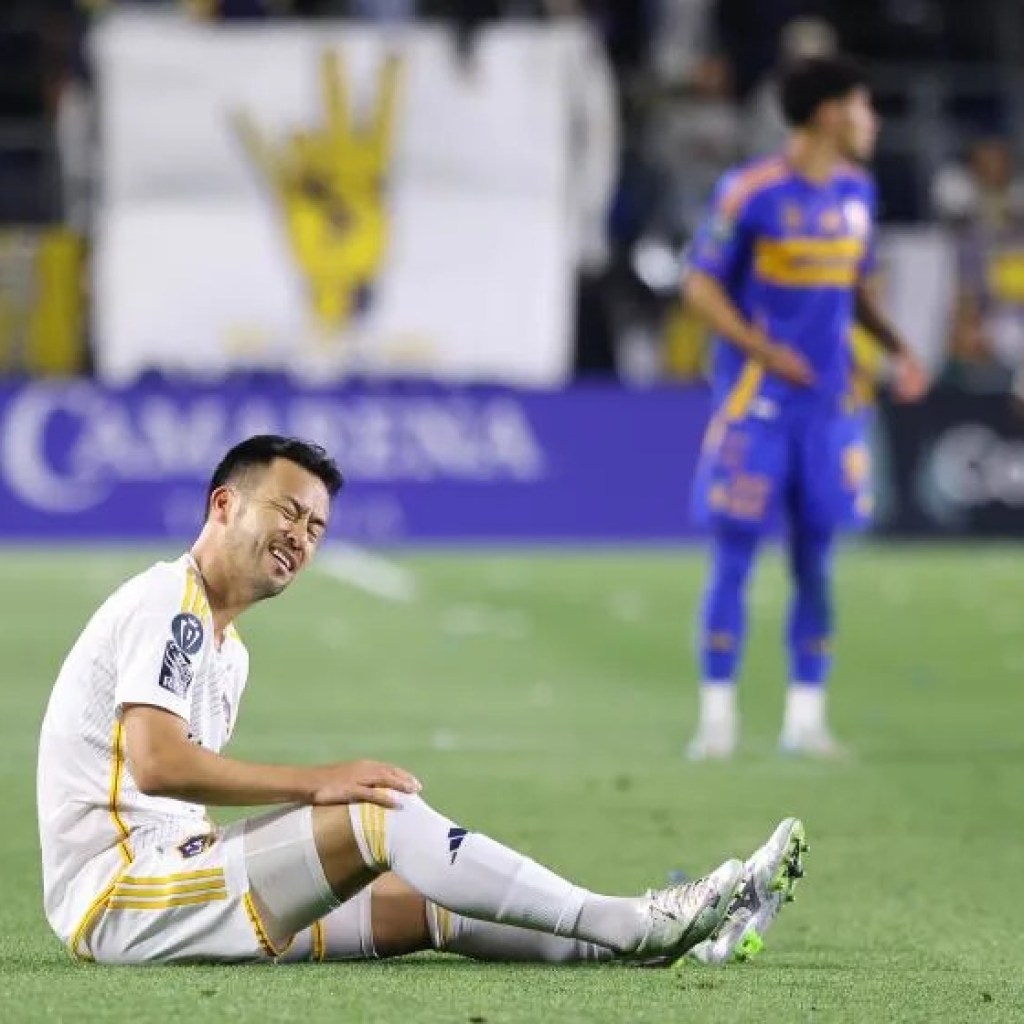The refrigerated vans will rumble down a thousand miles of freeway, tracked by the minute and full of rolls of essentially the most treasured grass in sports activities.
They’ll arrive at SoFi Stadium in Southern California, and at different NFL stadiums subsequent June, on the house stretch of a years-long seek for options to a downside: turf.
Commercial
Seven of have the substitute form; however worldwide soccer disdains it. So, as soccer’s crown jewel involves North America, famend professors, agronomists, engineers and development employees are on a mission to interchange artificial surfaces with what one professional lovingly calls “among the most micromanaged grass on the earth.”
Their mission has spanned continents and universities, “shade homes” and sod farms, solar and synthetic mild. It has price thousands and thousands of {dollars}. It has spawned uncertainty and nervousness. However quickly, organizers imagine, it’s going to assist carry the World Cup to life.
As a result of it has yielded a plan — one which SoFi Stadium will pilot on the CONCACAF Nations League finals subsequent week.
The plan is to weave synthetic fibers into pure grass grown on plastic; lay this “hybrid” grass on an modern drainage layer; and fuse collectively a short lived pitch on par with one of the best of the English Premier League, .
It should require “a military of individuals” and “a 24/7 operation”; computerized tractors and proprietary equipment; “exhaustive” testing and fixed tweaks over the approaching 15 months. It sounds, maybe, a bit extreme.
Commercial
However , it’s of “the best significance,” as World Cup chief Heimo Schirgi stated. And it’s needed, partly, as a result of earlier stateside soccer tournaments have been marred by
The latest main one, the , on a pitch that gamers stated felt “like a trampoline.” Argentina defender Cristian Romero the circumstances at Mercedes-Benz Stadium in Atlanta “very ugly.” U.S. midfielder Weston McKennie, , expressed a sentiment shared by a whole lot of execs who’ve visited NFL venues with makeshift mats for friendlies and different competitions: “It’s irritating,” he stated, to play “on a soccer discipline, with laid grass that’s all patchy, and it breaks up each step you’re taking.”
That, in a nutshell, is the issue FIFA confronted when it . Eight of the have synthetic surfaces. 5 have roofs. Some lacked underground infrastructure for air flow and irrigation. “It is actually tough,” says Adam Fullerton, Mercedes-Benz Stadium’s VP of operations, “to place grass in stadiums like this.”
So, over the previous few years, at FIFA’s command, they’ve constructed that important infrastructure. In session with researchers, they’ve developed novel schemes to develop and keep grass indoors. As showtime looms, and costume rehearsals close to, they’re assured in these schemes — but in addition nervous for one quite simple motive.
Commercial
“This,” says Otto Benedict, the SVP of services at SoFi Stadium, “hasn’t been achieved earlier than.”
Basic view of discipline preparations in anticipation of subsequent week’s CONCACAF Nations League matches at SoFi Stadium. (Gary A. Vasquez-Imagn Photographs)
(IMAGN IMAGES through Reuters Join / Reuters)From turf or grass to ‘hybrids’
The seek for options started, in earnest, again in 2019 at a well-known place. FIFA recruited after which , turfgrass gurus on the College of Tennessee and Michigan State, who in 1994 had confronted an analogous problem for soccer’s world governing physique: for North America’s final males’s World Cup.
Three many years later, they launched a multi-million greenback analysis undertaking. They used the “” at Tennessee to check indoor rising, and to trial under-surface supplies. They traveled the continent and the world, and used a patent-pending “fLEX” system — which simulates a cleated human foot hitting the grass, and measures the forces generated — to check “in all probability 125 stadiums,” together with “a number of in England,” Sorochan says. That testing, plus 1000’s of different knowledge factors, allowed them to ascertain “corridors,” or benchmarks, for the “ideally suited pitch.” The house fields of Arsenal (Emirates Stadium) and Aston Villa (Villa Park) have been deemed the gold requirements.
The fLEX machine exams how fields deal with actual participant actions by mimicking how athletes of various sizes — starting from 35 to 350 kilos — cease, begin and transfer on the floor. (Photograph courtesy of the College of Tennessee)
An inside have a look at the fLEX machine, which researchers use to learn the way nicely a discipline performs and whether or not it is protected for gamers. (Photograph courtesy the College of Tennessee)
However they might not, after all, simply copy and paste these pitches from England. Their 2026 World Cup venues include completely different capabilities and climates. Amongst these 16, they’ve taken an “à la carte” method, even to seemingly easy issues like grass sort. Toronto’s BMO Subject, for instance, had Kentucky bluegrass; Miami’s Exhausting Rock Stadium and several other others use Bermuda grass; Mexico Metropolis’s Estadio Azteca has Kikuyu grass, a species native to East African highlands that fits town’s altitude; SoFi and Lumen Subject in Seattle will want a “cool season” species — maybe a mixture of bluegrass and ryegrass — whereas Atlanta and Houston will in all probability get one thing else.
Commercial
One widespread thread, nonetheless, will bind all 16 fields. Even those that have already got pure grass will set up a specialised “hybrid” floor — a mix of 90-95% grass and 5-10% synthetic filament that’s widespread in Europe however uncommon in America. The bogus blades sit a quarter-inch beneath the true ones, reinforcing the pitch and including stability. They will both be stitched into the pure grass at stadiums, or basically baked into it on the birthplace of every World Cup discipline: the turf farm.
‘Probably the most micromanaged grass on the earth’
On the 650-acre Washington residence of , which can provide a couple of World Cup stadiums, the valuable grass will likely be planted this April. On a laser-graded, 100,000-square-foot plot, a double-drum asphalt curler creates a flawless base. Then a GPS-operated tractor locations a skinny layer of sand over plastic — which can bind the plant’s roots and hold them intact when harvested months later.
Subsequent comes a carpet of synthetic turf, however with a biodegradable backing. When the backing degrades, it leaves solely the artificial fibers, which peek above the floor as sand is added, three millimeters at a time. Then, seeds are planted; the pure grass basically grows up by these fibers, creating the hybrid combination that FIFA calls for.
Commercial
Then, for months, it have to be monitored and fed. Workers take moisture readings 4 instances per day, and punctiliously water it at evening. Each Monday, in addition they ship bunches of blades to a lab, which reads the grass’ vitals — nitrogen, phosphate, calcium, magnesium, iron and ranges of different hint minerals. These readings inform the garden care. “We gotta ensure that it is getting simply what the plant wants,” says Nathan Cox, Desert Inexperienced’s president.
They’ll nurture it for months, by the summer season and fall. They’ll examine it as soon as a day because it sleeps by winter. It should wake within the spring of 2026, and in June, quickly after its 13-month birthday, it will likely be prepared for showtime. Harvesting machines will slice it into 4-by-45-foot strips, roll it up, and cargo it into refrigerated transport containers known as reefers. The reefers, saved at 34 levels and hooked up to semis, will depart the farm at 15-minute intervals. Their drivers, two per truck, every vetted and ranked by common velocity, will then energy by a 20-hour journey to SoCal.
Greater than two dozen vans, every carrying 20-plus tons of sod, will join this multi-day, 1,200-mile meeting line. They’ll pull right into a loading dock at SoFi Stadium; the strips of sod will likely be laid, then hydraulically pressed collectively; and this detail-intensive course of — variations of which can happen at different farms and stadiums throughout America — will likely be full.
“Everyone,” Cox says, is “working across the clock.” Each piece has “a backup of a backup of a backup.” Every thing, says Evan Fowler, Desert Inexperienced’s VP, is “very technical” work that “takes quite a lot of cutting-edge stuff.”
Commercial
However in a means, it’s the simple half. Everybody’s certain that the sod farms will get it proper.
What FIFA and researchers had to determine was find out how to help this manicured grass at stadiums that weren’t constructed to take action.
A World Cup innovation
A “standard” soccer discipline sits on 12 inches of sand, and feeds on daylight plus water that may drain.
The fields that ill-equipped NFL stadiums have used for soccer through the years have been completely different — and generally poor. Strips of thick sod have been laid over synthetic turf or instantly on the stadium’s ground. Some performed high-quality, however others felt spongy or jumpy, relying on what, precisely, was beneath them.
Commercial
And if the fields have been laid only some days earlier than a sport, with inadequate time to settle, they’d be patchy. But when they have been laid too early for a multi-week match, with out correct irrigation and air movement, they’d begin to die.
The World Cup accentuated this problem. “It’s the most intense match schedule of any match,” says Alan Ferguson, FIFA’s discipline administration czar.
So, for 2026, the irrigation and air flow programs grew to become non-negotiables. Stadiums corresponding to SoFi, Mercedes-Benz in Atlanta, MetLife in New Jersey and Gillette in Massachusetts have undergone development this NFL offseason and final to prepared themselves. Some, like Atlanta, will set up their World Cup discipline months upfront, and take care of it like a everlasting pitch — albeit one which’ll then be eliminated earlier than the 2026 NFL season, as a result of .
Others, although, are planning to put in their World Cup fields in early June, and that is the place the college analysis is available in. Sorochan and Rogers developed what they name a “shallow pitch profile” — with a permeable black drainage module, which permits irrigation and SubAir programs, sitting between thinner sod and the stadium ground. The grass’ roots tack right into a geotextile, and the sphere’s texture feels pure. “You’ll be able to play on it,” Sorochan stated, “and the bottom response forces are the identical as a standard development construct.”
Permavoid is laid throughout the ground of SoFi Stadium beneath its short-term soccer discipline. (Photograph: Kjell Gerber, courtesy of SoFi Stadium)
(Photograph: Kjell Gerber through SoFi Stadium)
Staff set up the Permavoid drainage layer. (Photograph: Kjell Gerber, courtesy of SoFi Stadium)
(Photograph: Kjell Gerber through SoFi Stadium)
Sand is unfold atop the drainage layer. (Photograph: Kjell Gerber, courtesy of SoFi Stadium)
(Photograph: Kjell Gerber through SoFi Stadium)
Develop lights exchange pure daylight, and assist keep the grass, which is laid over sand. (Photograph: Kjell Gerber, courtesy of SoFi Stadium)
(Photograph: Kjell Gerber through SoFi Stadium)
Set up machines lay the Desert Inexperienced sod strip by strip. (Photograph: Kjell Gerber, courtesy of SoFi Stadium)
(Photograph: Kjell Gerber through SoFi Stadium)
Sustaining the sphere will nonetheless be difficult — and require ; these, as Benedict says, “replicate the pure daylight that grass needs.” They’ve turn out to be extensively used world wide, by soccer golf equipment (together with Arsenal) and marijuana growers and others. They’ll be at AT&T Stadium in Texas, and at Mercedes-Benz and SoFi, the place retractable roofs would possibly truly keep closed to “management variables.”
Commercial
Upkeep may also require each day testing by stadium-specific “pitch managers”; the exams will permit them to map the sphere, regulate their water provides or mowing methods, and fertilize the place needed all through the World Cup.
And it’ll, absolutely, require issues that no one ever thought-about.
“Clearly,” Ferguson says, “you by no means know till you truly ship the pitches.”
The ‘mannequin’ will get its first check
The primary reefers arrived at SoFi Stadium final week with a duplicate prepared for its truest check but. With development full, Desert Inexperienced’s crew put in what Benedict calls “the mannequin for the FIFA 2026 World Cup pitch that we’ll use [next summer].” They’re getting ready it for subsequent week’s Nations League semifinals — U.S. vs. Panama, Mexico vs. Canada — after which for a U.S. girls’s nationwide crew pleasant in opposition to Brazil subsequent month.
Commercial
“What we do right here in 2025,” Benedict stated, “[will allow us] to fine-tune and check and say, ‘Hey, what works, what would not?’”
They’ll analyze their new develop lights and mowing patterns. They’ll open and shut their retractable roof to evaluate air movement and the influence of actual daylight. They’ll host media occasions and workers soccer matches to “stress the grass,” Benedict says. And everybody, from FIFA to Benedict’s counterparts at different stadiums, will likely be watching.
“That is what ’25 is about,” Benedict explains. It’ll provide “affirmation or denial” that they’re heading in the right direction. This summer season’s and Gold Cup, which collectively will go to 10 of the 16 World Cup host cities, ought to provide extra proof. By the top of the 12 months, “we’ll in all probability have some fairly cool and fairly astonishing learnings,” Benedict says.
However nonetheless, there will likely be unknowns. There will likely be unexpected circumstances. “It will be anxious,” Benedict says with a slight grin, “all the way in which till someday in late July of ’26, after we can get this [field] out of right here.”








